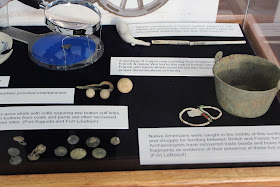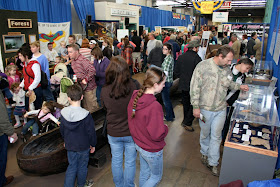Lawrence County is located in the extreme northwestern part
of Pennsylvania and is part of the Appalachian Plateaus physiographic province.
It is one of five counties that border the state of Ohio, the others being
Beaver, Mercer, Crawford and Erie. Lawrence County was formed on March 20, 1849
from parts of Mercer and Beaver counties. Lawrence County has a total
population of over 91,000 people living in an area of 363 square miles, all of
which is drained by the Shenango, Beaver and Mahoning rivers, Slippery Rock and
Connoquenessing creeks. Its name sake is taken from Commodore Perry’s warship,”
Lawrence”.
New Castle is the county seat originally founded on a 50 acre plot
of land at the confluence of the Shenango River and Neshannock Creek by John
Carlysle , a civil engineer charged with resurveying the region in 1798 (Donehoo
1928). A number of Indian paths crisscrossed the county and some of these were
chronicled as important multidirectional pathways as early as the 18th
century (Wallace 1965). As a direct influence, the region became an important
focal point for trading between Native and European traders. Principal Indian
towns of Delaware and Seneca attribution included “The Kuskuskies” towns centered
at the confluence of the Shenango and Mahoning rivers and at other locations
near the mouth of the Neshannock. Heckewelder (Donehoo 1928) noted that the
name Kuskuski was a corruption of Goshgoshing “the place of hogs”, assuming
that the name derived from the native’s propagation of this animal as a primary
food source.
Lawrence County is largely composed of Mississippian and Pennsylvanian periods
(360-290 million years in age) rocks consisting of sandstones, limestones,
shales and coal seams that were formed from a low lying swamp. Some of these
layers contain well preserved plant and animal fossils. Subsequently, millions
of years later the region experienced massive glaciations that eventually
retreated leaving the prehistoric landscape scoured and modified in many
places. Many of the glacial features such as eskers, moraines, and kettles can
still be observed throughout the county.
From an archaeological perspective Lawrence County has a
long and complex record. The Pennsylvania Archaeological Site Survey files
contain a total of 287 recorded archaeological sites or one site for every 1.28
square miles. Forty-four of these are historic period sites characterized by 18th,
19th and 20th century remains. Prehistoric sites are
mainly situated in riverine settings and
40% are found in upland settings . A variety of cherts represent the primary
lithic material. These were obtained from local glacial moraines and number of
prehistorically utilized quarries in northeast Ohio.
Middle Woodland artifacts from 36Lr5 (Mayer-Oakes 1955)
The entire continuum of Paleoindian through Historic Indian occupation
has been identified for Lawrence County (Mayer-Oakes 1955). Sites dating to the
Archaic and Late Woodland periods are the most common followed by Transitional,
Early, Middle Woodland and Paleoindian periods. A remarkable cache of stone and
copper artifacts is reported from a Middle Woodland mound on the Beaver River.
The cache was comprised of banded slate gorgets, pendants, cut sheet mica, a copper
bead and numerous projectile points. Among the latter at many sites in Lawrence County is a unique type called
“Raccoon Notched” which is common to the Beaver drainage and many other regions. Raccoon Notched points are exquisitely made out of high quality chert and their principal identification attributes are the square side
and/or corner notched base, overall thinness and pressure flaked surface. Bases
are typically square to concave with a decided break or gradual curve near its
distal end which gives the blade of the point a pentagonal or ovate shape. The
Raccoon Notched tradition has been formally described by Stanley Lantz (1989). These are very similar to the Jack’s Reef
projectile point type of eastern Pennsylvania and New York. Both may represent
arrow points rather than spear points.
Raccoon Notched projectile points from 36Lr3 (Mayer-Oakes 1955)
Jack's Reef projectile points top, Raccoon Notched projectile points, bottom : courtesy of The Carnegie Museum and Mark McConaughy
As we time travel through Lawrence County many Native
American sites of the Late Woodland/Late Prehistoric period become evident. Among
such sites are those found possessing a type of grit tempered cord-marked
pottery called Mahoning ware (Mayer-Oakes 1955). One of these sites is Coverts Crossing Site (36LR75), a
multi-component prehistoric site located
along the Mahoning River floodplain near New Castle, Pennsylvania. Phase I,II
and Phase III data recovery investigations were conducted there by GAI Consultants,
Inc., between 1998 and 2000 as part of the Coverts Crossing Bridge Replacement
Project (MacDonald 2000).
view of a site at the Coverts Crossing Bridge Replacement project
Two discrete soil deposits contained prehistoric artifacts: an
uppermost cultural stratum associated with a Late Woodland occupation and a
deeper Late Archaic occupation. Both occupations, though different in age,
apparently functioned as short term camps that were revisited over several
seasons. Although no postmold features, which often define house and other
structural patterns at a site were identified at Coverts Crossing, there were a
number of pit and hearth features in the two cultural bearing strata.
The uppermost deposit , or Late Woodland stratum, revealed
hearths and food processing pits of Native Americans that date between 900 and
1200 years ago. Their contents, comprised of charred corn, berry seeds, nuts ,
animal bones and triangular stone points (used to harvest the animals). These
dietary remains suggests that these people were foragers, hunters and farmers
who utilized the campsite during the late summer through early autumn.They cooked
or boiled some of their foods in a type of hand molded bag-shaped pottery
container that archaeologists call Mahoning Cordmarked (Mayer-Oakes 1955).
Mahoning Cordmarked ceramics (Mayer-Oakes 1955)
The deeper, or lower, Late Archaic stratum revealed hearths,
roasting pits and a lithic scatter, the latter essentially consisting of
discarded/lost stone flakes from the manufacture and re-sharpening of stone
tools that the Late Archaic people used in everyday life. These cultural
features and stone tool artifacts from the deeper stratum dated to
approximately 3500 years ago.
We hope you have enjoyed this glimpse into the
archaeological heritage of Lawrence County, for it is merely a glimpse. Hopefully it will inspire you to seek such
publications such as Prehistory of the
Upper Ohio Valley or Indian Paths of Pennsylvania. Understanding and exploring our
archaeological heritage is pivotal to our understanding of human behavior and
our ability to change and adapt over time- just as the peoples of Lawrence
County have done for thousands of years. Visit us again next week when we
present some interesting archaeological information about Lebanon County.
References
Donehoo, George P.
1928 A History
of the Indian Villages and Place Names in Pennsylvania. Harrisburg.
1989 Age, Distribution and Cultural Affiliation
of Raccoon Notched Point Varieties in Western Pennsylvania and New York. Bulletin
No. 28. Carnegie Museum of Natural History, Pittsburgh ………………………………
MacDonald, Douglas H.
2000 Phase I, II and III Archaeological
Investigations: The Coverts Crossing Site (36LR75). Final Technical Report.
Report prepared for Frank B. Taylor Engineering, New Castle, Pennsylvania.
Mayer-Oakes, William J.
1955 Prehistory of the Upper Ohio Valley: An
Introductory Archaeological Study. Anthropological Series, No.2. Annals of
the Carnegie Museum.
Wallace, Paul
A.W.
1965 Indian
Paths of Pennsylvania. The Pennsylvania Historical and Museum Commission.
Harrisburg.For more information, visit PAarchaeology.state.pa.us or the Hall of Anthropology and Archaeology at The State Museum of Pennsylvania .



































